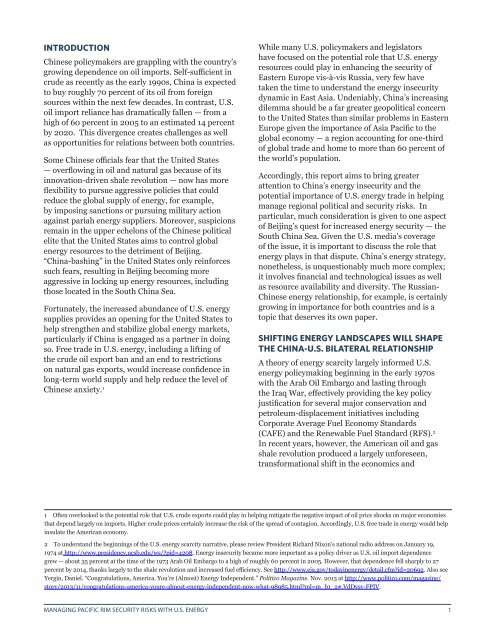Managing Pacific Rim Security Risks With U.S Energy
1WwUZP6
1WwUZP6
You also want an ePaper? Increase the reach of your titles
YUMPU automatically turns print PDFs into web optimized ePapers that Google loves.
INTRODUCTION<br />
Chinese policymakers are grappling with the country’s<br />
growing dependence on oil imports. Self-sufficient in<br />
crude as recently as the early 1990s, China is expected<br />
to buy roughly 70 percent of its oil from foreign<br />
sources within the next few decades. In contrast, U.S.<br />
oil import reliance has dramatically fallen — from a<br />
high of 60 percent in 2005 to an estimated 14 percent<br />
by 2020. This divergence creates challenges as well<br />
as opportunities for relations between both countries.<br />
Some Chinese officials fear that the United States<br />
— overflowing in oil and natural gas because of its<br />
innovation-driven shale revolution — now has more<br />
flexibility to pursue aggressive policies that could<br />
reduce the global supply of energy, for example,<br />
by imposing sanctions or pursuing military action<br />
against pariah energy suppliers. Moreover, suspicions<br />
remain in the upper echelons of the Chinese political<br />
elite that the United States aims to control global<br />
energy resources to the detriment of Beijing.<br />
“China-bashing” in the United States only reinforces<br />
such fears, resulting in Beijing becoming more<br />
aggressive in locking up energy resources, including<br />
those located in the South China Sea.<br />
Fortunately, the increased abundance of U.S. energy<br />
supplies provides an opening for the United States to<br />
help strengthen and stabilize global energy markets,<br />
particularly if China is engaged as a partner in doing<br />
so. Free trade in U.S. energy, including a lifting of<br />
the crude oil export ban and an end to restrictions<br />
on natural gas exports, would increase confidence in<br />
long-term world supply and help reduce the level of<br />
Chinese anxiety. 1<br />
While many U.S. policymakers and legislators<br />
have focused on the potential role that U.S. energy<br />
resources could play in enhancing the security of<br />
Eastern Europe vis-à-vis Russia, very few have<br />
taken the time to understand the energy insecurity<br />
dynamic in East Asia. Undeniably, China’s increasing<br />
dilemma should be a far greater geopolitical concern<br />
to the United States than similar problems in Eastern<br />
Europe given the importance of Asia <strong>Pacific</strong> to the<br />
global economy — a region accounting for one-third<br />
of global trade and home to more than 60 percent of<br />
the world’s population.<br />
Accordingly, this report aims to bring greater<br />
attention to China’s energy insecurity and the<br />
potential importance of U.S. energy trade in helping<br />
manage regional political and security risks. In<br />
particular, much consideration is given to one aspect<br />
of Beijing’s quest for increased energy security — the<br />
South China Sea. Given the U.S. media’s coverage<br />
of the issue, it is important to discuss the role that<br />
energy plays in that dispute. China’s energy strategy,<br />
nonetheless, is unquestionably much more complex;<br />
it involves financial and technological issues as well<br />
as resource availability and diversity. The Russian-<br />
Chinese energy relationship, for example, is certainly<br />
growing in importance for both countries and is a<br />
topic that deserves its own paper.<br />
SHIFTING ENERGY LANDSCAPES WILL SHAPE<br />
THE CHINA-U.S. BILATERAL RELATIONSHIP<br />
A theory of energy scarcity largely informed U.S.<br />
energy policymaking beginning in the early 1970s<br />
with the Arab Oil Embargo and lasting through<br />
the Iraq War, effectively providing the key policy<br />
justification for several major conservation and<br />
petroleum-displacement initiatives including<br />
Corporate Average Fuel Economy Standards<br />
(CAFE) and the Renewable Fuel Standard (RFS). 2<br />
In recent years, however, the American oil and gas<br />
shale revolution produced a largely unforeseen,<br />
transformational shift in the economics and<br />
1 Often overlooked is the potential role that U.S. crude exports could play in helping mitigate the negative impact of oil price shocks on major economies<br />
that depend largely on imports. Higher crude prices certainly increase the risk of the spread of contagion. Accordingly, U.S. free trade in energy would help<br />
insulate the American economy.<br />
2 To understand the beginnings of the U.S. energy scarcity narrative, please review President Richard Nixon’s national radio address on January 19,<br />
1974 at http://www.presidency.ucsb.edu/ws/?pid=4208. <strong>Energy</strong> insecurity became more important as a policy driver as U.S. oil import dependence<br />
grew — about 35 percent at the time of the 1973 Arab Oil Embargo to a high of roughly 60 percent in 2005. However, that dependence fell sharply to 27<br />
percent by 2014, thanks largely to the shale revolution and increased fuel efficiency. See http://www.eia.gov/todayinenergy/detail.cfm?id=20692. Also see<br />
Yergin, Daniel. “Congratulations, America. You’re (Almost) <strong>Energy</strong> Independent.” Politico Magazine. Nov. 2013 at http://www.politico.com/magazine/<br />
story/2013/11/congratulations-america-youre-almost-energy-independent-now-what-98985.html?ml=m_b1_2#.VdDvsv-FPIV.<br />
MANAGING PACIFIC RIM SECURITY RISKS WITH U.S. ENERGY 1


